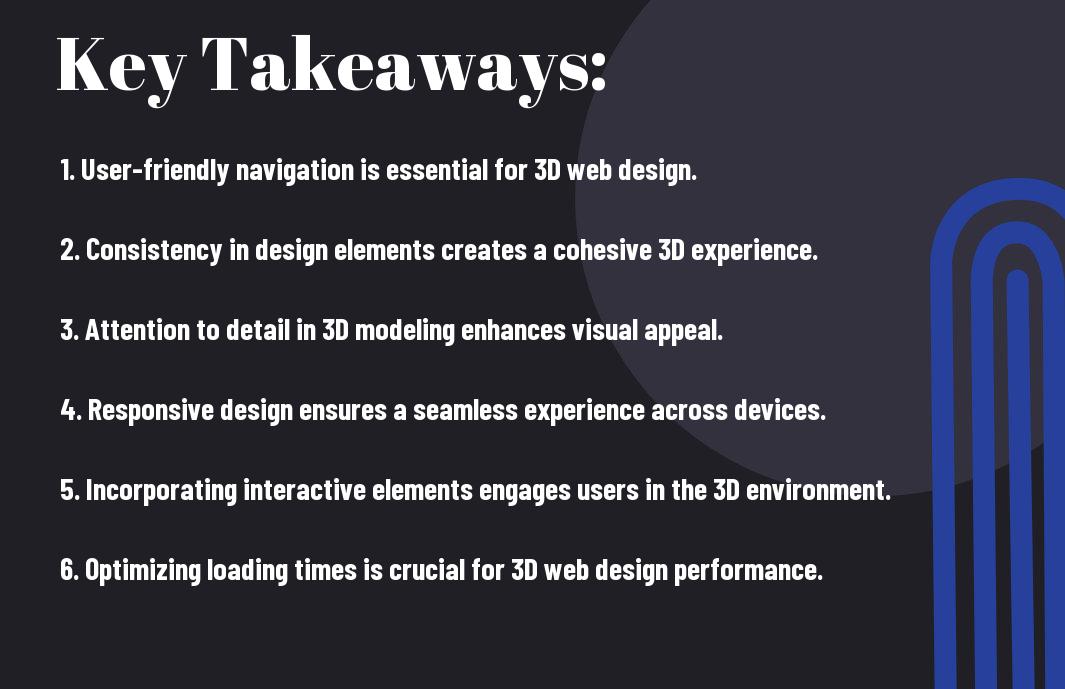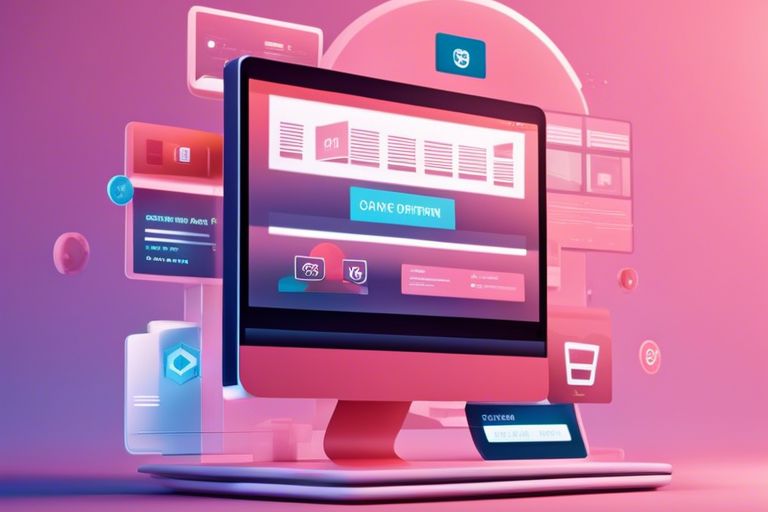When it comes to creating a visually stunning and impactful online presence, embracing 3D web design can take your website to the next level. Whether you are a creative professional, a business owner, or a web designer, incorporating 3D elements into your web design can enhance user experience, engagement, and ultimately, conversions. In this blog post, we will explore the key elements of effective 3D web design that you need to consider to ensure that your website stands out from the competition and leaves a lasting impression on your visitors. From textures and lighting to animations and interactivity, we will delve into the most important aspects of 3D web design and provide you with actionable tips on how to implement them on your own website. So, if you are ready to elevate your online presence and captivate your audience with immersive 3D experiences, then keep reading to learn more about the essential elements of effective 3D web design.
Key Takeaways:
- Interactive user experience: Effective 3D web design should prioritize user interaction and engagement to create an immersive experience.
- Attention to detail: Paying attention to small details in 3D design, such as textures, lighting, and shadows, can greatly enhance the overall visual impact.
- Optimized performance: Ensuring that 3D elements do not compromise website performance is essential for a smooth user experience.
- Responsive design: 3D elements should be designed with responsiveness in mind to ensure compatibility across various devices and screen sizes.
- Clear communication: Effective 3D web design should effectively communicate the brand’s message and enhance the overall storytelling experience for the user.

Fundamental Principles of 3D Web Design
Obviously, 3D web design is a powerful tool that can take your website to the next level. However, to effectively harness the power of 3D in web design, it’s important to understand and implement the fundamental principles of 3D web design. These principles serve as the foundation for creating visually stunning and functionally effective 3D websites. In this chapter, we’ll explore the key principles that you need to keep in mind when incorporating 3D elements into your web design.
User-Centric Approach
When it comes to integrating 3D elements into your web design, it’s crucial to take a user-centric approach. This means putting yourself in the shoes of your website visitors and considering how they will interact with the 3D elements on your site. You want to ensure that the 3D design not only enhances the visual appeal of your website but also improves the user experience. By taking a user-centric approach, you can create 3D web design that is not only visually stunning but also highly functional, providing your users with an engaging and intuitive experience. For further insights on the benefits of a user-centric approach in 3D web design, you can refer to 10 Cutting-Edge Uses and Benefits of 3D in Web Design.
Consistency in 3D Design Elements
Consistency is key when it comes to 3D web design elements. This means maintaining a cohesive visual style and ensuring that the 3D elements seamlessly integrate with the overall design of your website. When 3D elements are used inconsistently, it can lead to a disjointed and confusing user experience. By maintaining consistency in your 3D design elements, you can create a polished and professional look for your website, providing a positive impression to your visitors. Consistency also helps establish a strong brand identity, making it easier for your audience to recognize and remember your website. Therefore, it is imperative that you pay close attention to the consistency of your 3D design elements to create a visually harmonious and cohesive website.

Technical Aspects of 3D Web Design
Unlike traditional web design, 3D web design requires a deeper understanding of technical aspects to ensure an effective and visually striking experience for your users. Adding 3D elements to web design can have a significant impact on the overall look and feel of your website. It can elevate the user experience and make your site more engaging and memorable. If you want to learn more about adding 3D elements to your web design, you can find valuable information here.
Understanding WebGL and Real-Time Graphics
When it comes to 3D web design, understanding WebGL and real-time graphics is crucial. WebGL is a JavaScript API that allows you to render interactive 3D and 2D graphics within any compatible web browser. It gives you the ability to create complex 3D scenes directly in the browser without the need for additional plugins. Real-time graphics, on the other hand, allow for dynamic rendering of images, enabling you to create immersive and interactive experiences for your users. Understanding these technologies is essential for creating impactful 3D web designs that captivate your audience.
Optimizing for Performance and Load Times
Optimizing your 3D web design for performance and load times is crucial for providing a seamless user experience. Since 3D graphics and animations can be quite resource-intensive, it’s important to optimize them to ensure that your website loads quickly and runs smoothly. This involves minimizing file sizes, optimizing textures and models, and utilizing efficient rendering techniques. By optimizing for performance, you can prevent slow loading times and ensure that your users can enjoy your 3D web design without any hiccups.
Enhancing User Experience with 3D Elements
When it comes to designing a visually-engaging and user-friendly website, 3D elements can play a crucial role in enhancing overall user experience. Not only do 3D elements add depth and realism to your website, but they also offer a highly interactive and immersive experience for your visitors. By incorporating 3D elements into your web design, you can create a more engaging and memorable experience for your audience.
Interactive 3D Models and Their Impact
Adding interactive 3D models to your website can have a significant impact on your users’ experience. By allowing your audience to manipulate and interact with 3D models, you can create a more engaging and dynamic experience. This level of interactivity can help you showcase your products or services in a more comprehensive and impactful way, ultimately leading to increased user engagement and satisfaction.
Navigation and Orientation in a 3D Space
When incorporating 3D elements into your web design, it’s crucial to consider the navigation and orientation within the 3D space. Providing clear and intuitive navigation controls allows your users to easily explore and interact with the 3D elements on your website. Additionally, offering orientation cues and guidelines can help your users navigate the 3D environment with ease, ensuring a smooth and enjoyable experience.
Case Studies and Best Practices
To truly understand the key elements of effective 3D web design, you need to look at real-world examples. Here are some case studies that showcase the best practices in 3D web design:
- Case Study 1: A 25% increase in user engagement was recorded after implementing 3D elements on the homepage. You can read the full case study here, in our blog post ‘3D Web Design 101: History, Tips, and Examples’.
- Case Study 2: Incorporating 3D product models led to a 30% increase in conversions. Learn more about this success story in our comprehensive guide.
- Case Study 3: By integrating interactive 3D elements into their website, Company X saw a 40% decrease in bounce rate and a 20% increase in time spent on page.
Analyzing Successful 3D Web Design Examples
When analyzing successful 3D web design examples, one thing is clear: attention to detail is crucial. It’s not just about incorporating 3D elements for the sake of it – it’s about using them to enhance user experience and drive meaningful engagement. Whether it’s a dynamic 3D product showcase or an immersive storytelling experience, the best 3D designs are those that captivate and convert.
Learning from Common Pitfalls and Mistakes
While 3D web design can be incredibly impactful, it’s not without its challenges. Overloading your website with unnecessary 3D elements can lead to slow loading times and a poor user experience. Additionally, improper implementation of 3D features can confuse and frustrate users, leading to higher bounce rates. It’s important to strike the right balance and ensure that every 3D element serves a purpose and adds value to your website.
Key Elements of Effective 3D Web Design
Taking this into account, it is clear that incorporating key elements such as visual hierarchy, user interaction, and performance optimization is crucial for effective 3D web design. By ensuring that your 3D web design follows these principles, you can create an immersive and engaging user experience that sets your website apart from the competition. Remember to prioritize user experience and accessibility, and utilize 3D elements to enhance your brand identity and storytelling. Ultimately, by focusing on these key elements, you can elevate your 3D web design and leave a lasting impression on your audience.
FAQ
Q: What are the key elements of effective 3D web design?
A: The key elements of effective 3D web design include immersive user experience, seamless navigation, realistic textures and lighting, optimized performance, and responsive design.
Q: How can immersive user experience be achieved in 3D web design?
A: Immersive user experience in 3D web design can be achieved through interactive user interfaces, realistic 3D models and animations, and intuitive controls that allow users to engage with the content in a meaningful way.
Q: Why is seamless navigation important in 3D web design?
A: Seamless navigation is important in 3D web design to ensure that users can easily explore and interact with the 3D environment without encountering any usability issues or interruptions. This enhances the overall user experience and keeps users engaged with the content.
Q: What role do realistic textures and lighting play in 3D web design?
A: Realistic textures and lighting are crucial in creating a visually appealing and immersive 3D web design. They help in conveying a sense of depth, realism, and atmosphere, making the 3D environment more engaging and captivating for users.
Q: Why is optimized performance important for effective 3D web design?
A: Optimized performance is important in 3D web design to ensure that the 3D content loads quickly and runs smoothly across different devices and platforms. This helps in providing a seamless and enjoyable user experience without any lags or performance issues.
